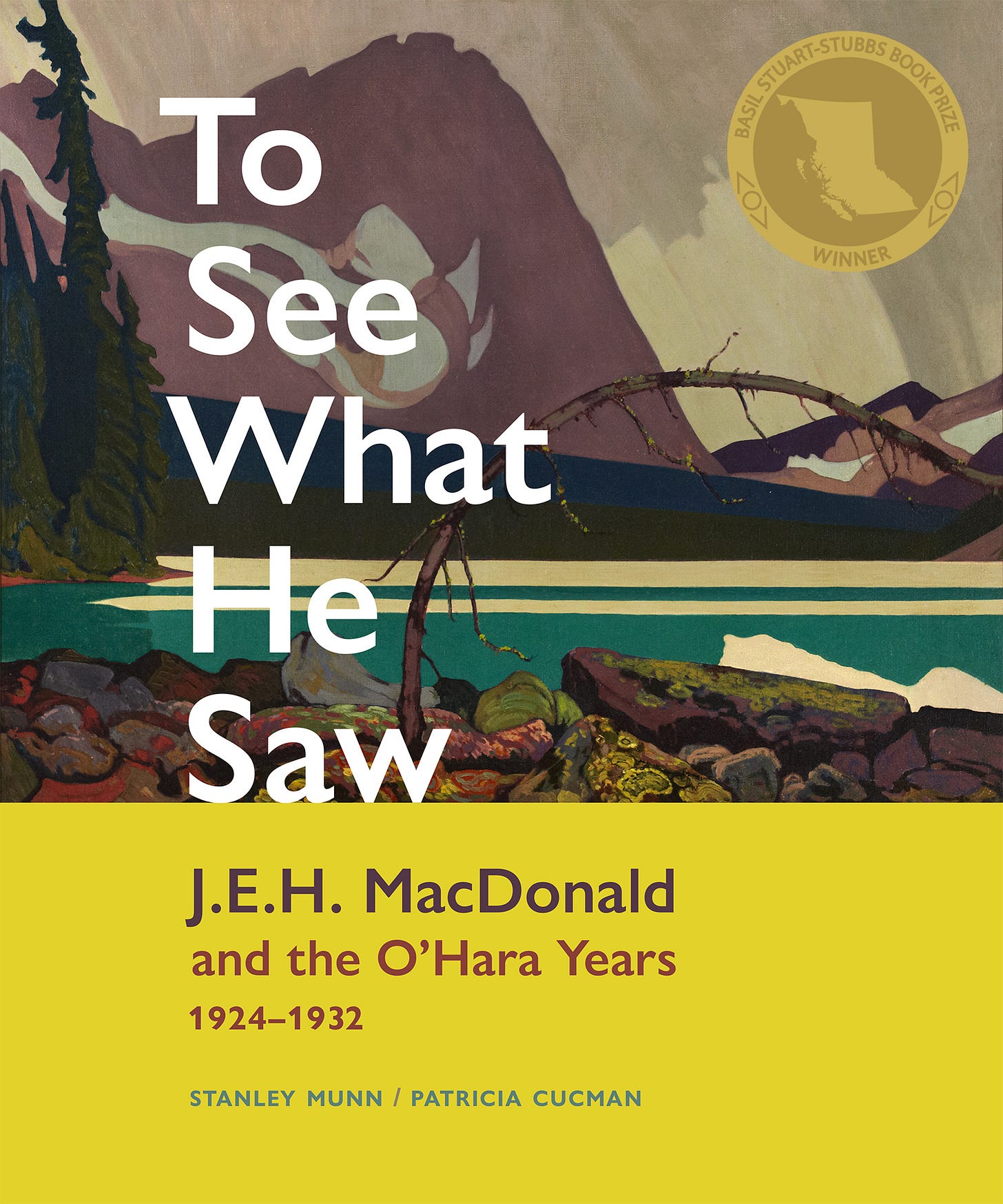To See What He Saw: J.E.H. MacDonald and the O’Hara Years, 1924 - 1932 By Stanley Munn, Patricia Cucman
Review by Laura Patterson
Can you imagine loving a place so much that you would journey on foot and by horseback through an untamed land year after year just to paint? Well, that is exactly what artist J.E.H MacDonald did. Between 1924 and1932, the English Canadian artist made seven trips into Yoho Provincial Park in The Rocky Mountains of British Columbia to spend time painting Lake O’Hara and its surrounding mountainous beauty.
A member of the Group of Seven, MacDonald’s painting style showcased Canadian landscapes in vivid colours with incredible depth, energy, and movement. To See What He Saw by Stanley Munn and Patricia Cucman, documents MacDonald’s trips to Lake O’Hara and serves as a catalogue of over two hundred pieces of his work painted in that area. Through diary entries, essays, en plein air sketches and studio works, MacDonald’s paintings come to life with every turn of the page. Present day photographs, taken from the same locations where MacDonald had sat to paint his works, accompany each sketch showing the changes in the landscape over the last hundred years.
“Every time I opened this book, I felt a little bit of that magic MacDonald must have felt.”
I’ll be the first to admit that I know very little about art, but I do really appreciate oil on canvas, which adds an immense amount of depth and texture to a painting. MacDonald painted with this medium often, and I wish I could see his works in person, as I’m sure they are absolutely breathtaking. Something else I love about MacDonald’s paintings is his talent with colour. The greens and blues he used really captured the mineral-rich waters of Lake O’Hara and the ever-changing skies. It is noted throughout the book that MacDonald painted what he saw, meaning he was able to expertly display changes in the weather and all the fog, clouds, and sun beams that went along with it.
On top of the stunning artwork encapsulated in this beautiful book, there is also the story of J.E.H. MacDonald, which eventually brought me to tears. I thoroughly enjoyed his diary entries and the old photos of MacDonald with his friends and fellow painters. To be surrounded by such beauty in the company of like-minded individuals would have been so comfortable and liberating. In his later letters, MacDonald speaks of wanting to go back to his beloved Lake O’Hara, but his poor health would not allow it. How sad it must have been for him to realize that he would never return to that place of wonder that served as his muse for so many years.
What a wonder Lake O’Hara must have been back in the day, so hidden and protected. To see this gorgeous, isolated area, wild and fresh, before the highways were built and tourists arrived en masse would have been worth the arduous trip. Every time I opened this book, I felt a little bit of that magic MacDonald must have felt. Knowing that I was looking at sketches and paintings created through his eyes over one hundred years ago was incredible. What is even more remarkable is how much of the area has stayed relatively untouched, the same trees and rocks, the same majestic peaks.
How amazing it must have been for Munn and Cucman to sit in the same spots as MacDonald and to find the exact locations where he created his masterpieces. To relive that history and to compile all the elements of To See What He Saw would have been not only a huge honour, but also a once in a lifetime accomplishment paying tribute to an artist who broke free from traditional painting styles of that time to give us such vivid, living, emotional works of art.
About the Authors
Stanley Munn, a retired exploration geologist, fell in love with photography at an early age. He started with black-and-white film, processing his work in a home dark room, and eventually incorporated digital technology into his photography. He rarely left home without a camera in hand. His photographs have appeared in various books and publications.
Patricia Cucman is a retired petroleum geologist. After retirement, she and her husband, Stanley Munn, spent twenty years re-exploring Lake O'Hara together with a view to experiencing the area through the eyes of the Group of Seven painter. She has always had a passion for learning, the creative process, and puzzle-solving, and applied these skills to the collection, organization, and assessment of the research materials that form the foundation of this publication. She lives in Calgary, Alberta, Canada.
Anne Ewen is the Director and Chief Curator of Art and Heritage at the Whyte Museum of the Canadian Rockies. She has enjoyed a distinguished career as an art curator, arts administrator, author, heritage consultant, and mentor to emerging artists and curators. She lives in Banff, Alberta, Canada.
Book Details
Publisher : Figure 1 Publishing
Publication date : June 18 2024
Language : English
Print length : 352 pages
ISBN-10 : 1773272500
ISBN-13 : 978-1773272504




